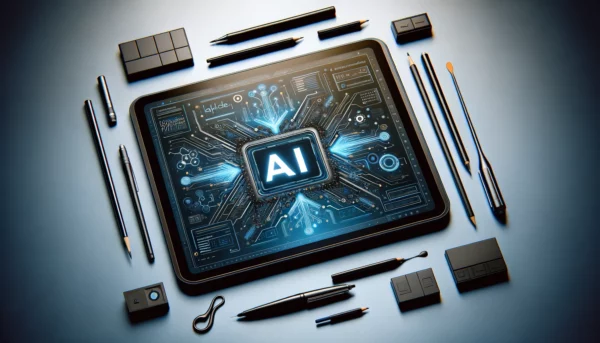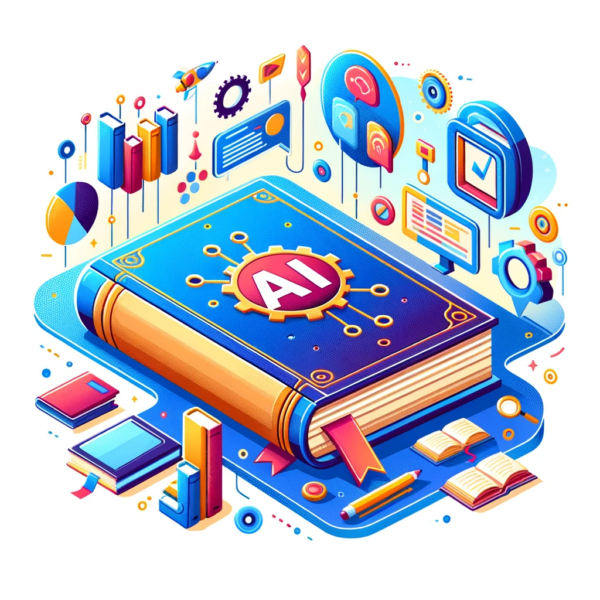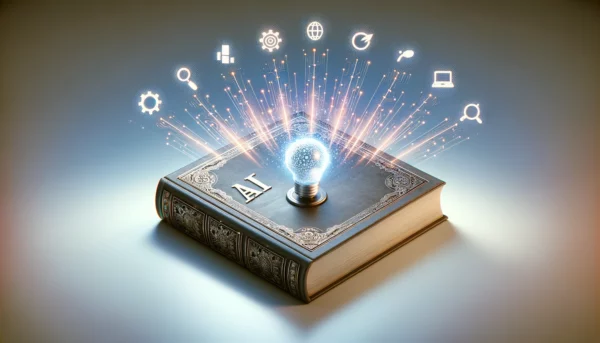For centuries, storytelling has been a powerful way to connect, inspire, and entertain. From ancient myths whispered around campfires to epic novels that draw readers into new worlds, stories have always been at the heart of human experience. They carry the essence of culture, emotion, and imagination, captivating audiences through the ages. So, where does using AI for storytelling come in..?
Today, a new kind of magic is reshaping the art of storytelling—artificial intelligence. Once a realm reserved for sci-fi tales, AI has stepped into the spotlight as a tool that helps writers craft stories in once unimaginable ways. Like a digital sorcerer, AI can conjure up characters, weave intricate plots, and even generate vivid visuals that bring stories to life.
But this magic doesn’t replace the storyteller; it enhances their craft, offering fresh perspectives and unexpected twists. With AI, writers can explore new horizons, sparking ideas and spinning tales that blend human creativity with technological innovation. As we journey deeper into this evolving landscape, we see that AI’s role is not just to assist but to inspire, opening the door to endless narrative possibilities.
The Rise of Using AI for Storytelling: A New Era of Creativity
AI for storytelling refers to the use of artificial intelligence to assist in creating narratives, characters, and plots. Over recent years, this technology has rapidly evolved, moving from simple text generators to sophisticated tools capable of producing coherent, engaging stories. Early versions could only piece together words, but modern AI systems like GPT-3, ChatGPT, and Jasper have advanced significantly, capable of generating complex narratives, dialogues, and even full-length scripts.
Your Publishing Journey Awaits – Start NowThese AI storytelling tools are transforming the traditional narrative landscape. Writers can now use AI to brainstorm ideas, flesh out character backstories, or even draft entire chapters. In the world of gaming, AI helps develop dynamic plotlines that respond to players’ actions, creating a more immersive experience. In films, AI can assist in scriptwriting and generate storyboards that visualize scenes before they are shot.
As a result, AI isn’t just speeding up the creative process; it’s expanding the possibilities of storytelling across mediums. From novels to movies and video games, AI is opening new pathways for creators, bringing forth a blend of innovation and imagination that redefines what stories can be.
How AI Storytelling Tools Work: Behind the Scenes
At the core of AI, storytelling tools are algorithms powered by data and machine learning. These tools analyze vast amounts of textbooks, articles, and scripts—and learn the patterns, structures, and styles that make a story engaging. Think of it as feeding an AI a library of knowledge, allowing it to absorb the art of storytelling over time.
When writers use these tools, the AI acts like a storyteller pulling ideas from a hat, but instead of random guesses, it draws from a deep well of data. It processes input prompts, generates content, and can create characters, plots, or even entire fictional worlds. By analyzing themes, tones, and styles, AI can weave together narratives that feel surprisingly coherent and lifelike.
For example, if you ask an AI to generate a fantasy story, it will pull from its ‘hat’ of data—recognizing elements like heroic quests, mythical creatures, and magical realms—turning this information into narrative magic. In this way, AI doesn’t just mimic storytelling; it creates a dynamic interplay between data and creativity, helping writers to build immersive stories more efficiently than ever before.
Benefits of AI in Storytelling: Enhancing Creativity
AI storytelling tools are like digital co-writers, providing creative support that can elevate the writing process in several ways.
Generating Ideas:
One of the most significant benefits of AI is its ability to assist in brainstorming. Writers often face the challenge of staring at a blank page, searching for inspiration. AI can quickly suggest unique plots, character ideas, and story arcs based on prompts, helping writers overcome creative blocks. By analyzing countless stories, AI can generate unexpected twists, intriguing settings, and diverse characters, sparking new ideas that writers might not have considered.
Creating Visuals:
Beyond just text, AI can also generate visuals, enhancing the storytelling experience. Tools like DALL-E or Midjourney can create images of characters, landscapes, or key scenes, helping authors visualize their narratives. This ability allows for richer world-building and can even serve as inspiration for writing, giving authors a clearer picture of the worlds they’re crafting.
Speed and Efficiency:
AI accelerates the writing process by offering quick drafts, reducing the time it takes to get from concept to completed manuscript. Whether it’s generating dialogue or drafting a scene, AI can provide instant suggestions, allowing writers to focus on refining and editing rather than starting from scratch.
Inspiration and Exploration:
AI can also push writers to explore new genres, styles, or themes. By experimenting with AI-generated content, writers might find themselves inspired to write in a new voice or tackle a different type of story. This exploration broadens creative horizons, enabling authors to venture into uncharted narrative territory with the support of AI’s insights.
Overall, AI in storytelling acts as a versatile tool, helping writers craft compelling, imaginative stories faster and with more inspiration than ever before.
Limitations of AI Storytelling: The Human Touch Matters
While AI can be a valuable tool in storytelling, it has its limitations—particularly when it comes to capturing the essence of what makes stories truly resonate with audiences.
Your Publishing Journey Awaits – Start NowLack of Emotion and Context:
AI-generated content often struggles with emotional depth. Storytelling is about more than just stringing words together; it’s about conveying feelings and crafting moments that make readers laugh, cry, or reflect. AI can generate coherent narratives, but it may lack the subtlety required to evoke genuine emotion. Without real-world experiences or empathy, AI can miss the context that breathes life into a story.
Originality Concerns:
Another limitation is originality. While AI can create compelling plots and characters, it does so by drawing from existing data. This means that, at times, the content it generates can feel repetitive or derivative. Since AI relies on patterns, it may inadvertently mimic existing works, leading to narratives that lack a fresh, original voice.
Understanding Nuance and Tone:
Storytelling often relies on nuance—an inside joke, a subtle hint, or a layered metaphor. AI can struggle to grasp these complexities, making it challenging to produce content with humor, sarcasm, or intricate themes. This limitation can lead to misinterpretations, where AI-generated content falls flat or misses the mark entirely.
The Role of the Writer:
Ultimately, while AI can assist in generating ideas, creating visuals, and speeding up the writing process, it cannot replace the creativity and soul of a human storyteller. Writers bring a unique perspective, personal experiences, and emotional intelligence that machines cannot replicate. The most engaging stories are those that reflect the complexities of life, and that require a human touch. AI may be a tool, but the storyteller remains at the heart of every tale, guiding it with passion, intuition, and imagination.
Striking the Balance: Using AI to Enhance, Not Replace
AI can be a powerful ally for writers, but the key is to use it as a tool that enhances, rather than overshadows, their creative process.
Collaborative Creativity:
When used thoughtfully, AI can serve as a collaborative partner that supports writers in developing their ideas. It can help brainstorm new plot twists, suggest character arcs, or generate snippets of dialogue. However, it’s the writer who brings the story’s essence to life, ensuring that the narrative reflects their unique voice and vision. By weaving AI-generated content with their own creativity, writers can explore new directions while maintaining control over the final product.
Practical Examples:
AI has already been successfully integrated into various storytelling projects. For instance, AI tools have been used to craft intricate plotlines in video games, where characters’ actions and dialogue adapt to player choices, creating a dynamic experience. In the world of literature, authors have experimented with AI to co-write novels, using it to generate drafts that they refine and build upon. Even in film, AI has been utilized to analyze scripts, suggest edits, and generate storyboards, streamlining the production process.
Blending Technology and Art:
The real strength of AI in storytelling lies in its ability to blend technology with art. It can help visualize stories by generating images, crafting compelling dialogue, or building dynamic plotlines. Yet, even the most sophisticated AI still requires a human hand to refine its output, ensuring that characters are relatable and the narrative feels authentic. Technology can assist in the creative process, but it’s the human touch that adds depth, emotion, and nuance, transforming a script or a plot into a story that resonates with audiences.
By striking the right balance, writers can harness AI’s potential to enrich their storytelling, using it to expand their creative toolkit without losing the heart and soul of their work.
The Tale of Two Storytellers
In the evolving world of storytelling, AI and human creativity stand side by side, each bringing their strengths to the narrative process. While AI offers speed, ideas, and visual flair, it’s the human storyteller who breathes life into the story, adding depth, emotion, and nuance. Together, they create a synergy that can transform how we craft and experience stories.
Rather than seeing AI as a replacement, think of it as a helpful companion—one that can amplify your creativity, spark new ideas, and open doors to unexplored worlds. Imagine a storyteller with an endless bag of tricks, each one a blend of technology and imagination, ready to bring your next big idea to life.
The future of storytelling is a tale still unfolding, where the possibilities are as vast and limitless as our dreams. With AI and human creativity working together, who knows what incredible stories await?
Ready to see the balance of AI and human creativity within the publishing world making your storytelling dreams come true? At Spines, we can show you the way to an efficient, high-quality publishing journey without discarding your human creativity in the project. Check us out today!
Your Publishing Journey Awaits – Start Now







